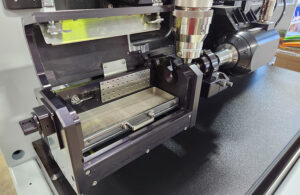
A partnership with Omron Automation Americas enabled Alpine Laser to create what it describes as an easy-to-support, modular machine for cutting stainless steel medical tubing.
Alpine Laser (Bloomington, Minnesota) recently launched its medical-tube-cutting Medicut Pro.
Alpine Laser describes the Medicut Pro as a purpose-driven and ultra-fast laser processing workstation for cutting stainless steel tubing. Such stainless-steel tubing plays an important role in microcatheter shafts, structural heart valve frames, stents and tubular components.
The Medicut Pro is faster (by a factor of two or more) than other systems on the market, according to Alpine Laser. Other positive features include a Precision Regrip Module with less than .0005 in. positional error, 3- to 5-minute tool changeover and rapid prototyping, a CAT III safety system, and the ability to service with off-the-shelf products that Alpine stocks.
Historically, medical device companies would adapt general-purpose machines to cut medical tubing. Alpine Laser officials thought they were well-positioned to improve on the situation and reduce the margin of error for such machines.
“We are a group of people with backgrounds in industrial machine design, high-volume medical manufacturing, and the medical device/therapy space. We deeply understand the needs of the customer and the market,” Joe Kempf, Alpine Laser’s founder and commercial leader, said in an article provided to Medical Tubing + Extrusion and Medical Design & Outsourcing by Omron Automation Americas.
Q&A: Omron and Alpine discussed their partnership in a Medical Design & Outsourcing webinar — watch the replay now.
How Omron helped create Alpine Laser’s Medcut Pro
The Medicut Pro features an advanced motion control platform from Omron Automation Americas (Hoffman Estates, Illinois). Company officials say the platform has near-limitless access to tuning parameters coupled with high-speed remote I/O modules. The result, according to the companies, was that Alpine could build high-performance workstations in a very efficient and economical way.
In addition, the Omron support team helped ensure that Alpine followed best practices in developing the laser processing workstation’s architecture. As a result, the control architecture’s design promotes ease of service and quick replacement in the unlikely event of failure, according to the companies.
The role of Omron’s advanced motion engineering support
Omron field engineering teams provide support that includes onsite collaboration, application notes, phone and web conferences. Omron worked directly with Alpine Laser from the very beginning of the project. It says its motion engineering services helped reduce time-to-market.
Kempf said: “The advanced motion engineering team was instrumental in supporting and training our engineering team to significantly shorten our time-to-market. Their ability to quickly and precisely answer questions is second to none.”
This post was originally published in November 2022 and updated in February 2023 with webinar information.

